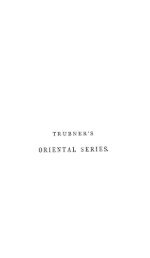Untitled
Untitled
Untitled
Create successful ePaper yourself
Turn your PDF publications into a flip-book with our unique Google optimized e-Paper software.
For more than two centuries which elapsed between the fall of the<br />
Samanid and the rise jf the Mongol power there existed in Transoxiana<br />
a^M.uslim Turkish dynasty variously known as " Ilak-Khani," "Kha,ni"<br />
and " Afrasiyabi." These the Qara-Khita'is suffered to remain, only<br />
requiring of them the payment of tribute and the acceptance of a<br />
political resident (Shahna) it their Court. From most of the Khwarazm-<br />
'<br />
shahs also they received tribute uatil overthrow;! by them in 607/1210-11<br />
as mentioned above.<br />
This collapse of the Qara-Khita'i power proved, in fact, to be a great<br />
calamity for the Khwarazm-shahs in particular and the Muslims in general,<br />
for' thereby was broken down a barrier which* had hitherto effectively<br />
protected them from the Mongols and other predatory heathdns who<br />
dwelt further to the north and east, and so was prepared that great<br />
catastrophe which shortly afterwards laid waste the Muslim world; a<br />
fact emphasized by Ibnu'l-Athir (ed. Tornberg, xii, p. 235) in a passage<br />
translated in the second volume of my Literary History of Persia, p. 430.<br />
The word Gitr-Khdn 1<br />
(otherwise Ktir-KMn, Kit-Khan, Uz-Khdn,<br />
Ur-Khdn or Or-Khdn} was a generic title of these Kings, not the proper<br />
naxieof anyoneof them. Ibnu'l-Athir : says "Ku in the Chinese language<br />
is & title given to the greatest of their Kings, while Khan is a title of the<br />
Kings of the Turks, so that it<br />
[the compound Ku-Khdn\ means 'Greatest<br />
of Kings'." In the Ta'rikh-i-Jahdn-gushdy (vol. ii, p. 86) and in the<br />
To? rikh-i-Jahdn-drd also it is explained as Khdn-i-Khdndn, i.e. "Khan<br />
of Khans " or " Great Khan " and on the ; same authority the name<br />
of this particular Gur-Khdn is said to have been Qiishqin Tayqu.<br />
Dr Babinger has kindly called my attention to a note on Ibn 'Arabshah's<br />
in the Memoires de fAcademic<br />
explanation of Giir-Khdn by S. de Sacy<br />
for 1822, p. 476.<br />
X. Atmatigin, Amfr Bayabani and Atsiz.<br />
, (Text, p. 22 ; Persian notes, p. 114.)<br />
The correct form and signification of the first and second of these<br />
three names is uncertain, and the MSS. differ in their readings. The<br />
first has been found by Mirza Muhammad in the History of Bukhara of<br />
Muhammad ibn Zufar ibn 'Umar, composed in 574/1178-9, only 38<br />
years' after the Battle >f Qatawan, but here also the MSS. differ, the<br />
British Museum MS- (Add. 2777, f. 28 a ) having ^ Aymantigin " or<br />
"Imantigin," and the Bibliotheque Nationale MS. (Suppl. Pers. 1513,<br />
"<br />
Alitigin." It is evidently one of the numerous Turkish names<br />
f. 23 b )<br />
ending in tigin (like Subuktigin, Alptigin, etc.)<br />
but the first element<br />
remains doubtful > The same uncertainty affects "the son of the Amir<br />
Bayabani, on whose identity no satisfactory light has yet been thrown."<br />
1 Mirza Muhammad cites two passages which show, by the word-plays wherein<br />
lies thei' point, that by the Persians at any rate the pronunciation Gur-Khdn was<br />
adopted. Khaqani says :<br />
'<br />
'<br />
j*-' O^Jr els' *<br />
See alscovol. ii, p. 93 of the Tc?rlkh-i-fahdn-gushdy :<br />
J<br />
i<br />
i<br />
'








![La religione di Zarathustra nella storia religiosa dell' Iran [microform]..](https://img.yumpu.com/15970820/1/151x260/la-religione-di-zarathustra-nella-storia-religiosa-dell-iran-microform.jpg?quality=85)


